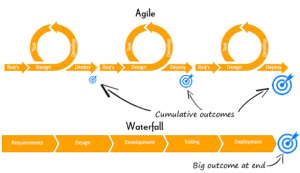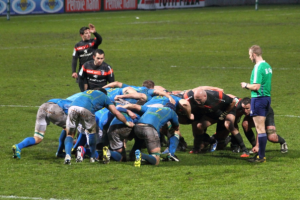
2014 Women’s Six Nations Championship, France versus Italy. Photograph by Pierre-Selim Huard. Courtesy of Wikimedia Commons.
The Group Problem
A cursory scroll through the Facebook group, GT Memes for Buzzed Teams, turns up a number of meme gems related to group projects. Take, for instance, the image below of a red-faced man (labeled “me”) straining to pick up a giant boulder (labeled “group project”) while a bystander (labeled “my groupmates”) stares, slack-jawed and unhelpful, in the background. Or this one below on the right, which features a muscular Atlas (“the one person who actually knows what’s going on”) holding up the globe that is “my senior design group.”

Sujay Pandey, Boulder lifting meme

Jay Rockholt, Atlas meme
Or, finally, the obituary-style meme featuring the byline “When I die, I want the people I did group projects with to lower me into the ground so they can let me down one last time” under a young woman’s portrait. The humor of these memes comes from the commonly-accepted truism that group work is intrinsically unfair. And, indeed, group projects are a tricky balancing act between realism (“You’ll have to put up with that behavior in the workplace so you might as well start now”) and fairness (“Why should my worthless partner get an A when I did all the work?”). Instructors often describe these bugs as features—group work ideally helps students learn to take responsibility for the end product and to coordinate efforts with others. Everyone will have that coworker, and part of the grade is learning how to work around them and despite them, or even, if you’re lucky, to motivate them to do some work and hold them accountable.
Instructors have dealt with the problems of group collaboration in a variety of ways, from simply not assigning group projects (a less practical solution when you teach a large number of students each semester) to requiring groups to meet with the instructor at stated intervals throughout the semester to make sure they are still on track. One approach that I have found works well to mitigate unfairness in group work and to reward effort is the Agile philosophy of project management. I’ll be detailing in this post how I apply Agile philosophy to my composition classes’ group assignments. First, it is helpful to have some background on this rather diffuse and widespread movement
Agile Origins
The Agile philosophy made a splash in the tech world in the early 2000s as a way to foster adaptive, iterative, and collaborative software development. Its essential features are short, frequent meetings, called “scrums” or “standups,” and phases of project development that are broken up into quick “sprints” rather than long cycles. Because each sprint is relatively short and team members touch base regularly, it is easy to adapt to client and product needs as they emerge. This philosophy is a reaction to other ones such as the Waterfall process that tend to spend more time up front getting requirements and making designs.

QualityProInc, Application of Agile
Rather than beginning by working out detailed specifications for a project and making a comprehensive plan, students iteratively revisit the requirements for their projects as they move, responding with agility to the unforeseen challenges that inevitably emerge during a project’s life cycle. These principles gave birth to a variety of implementation methodologies, such as Scrum, Lean, and Extreme Programming (XP). More recently, Agile implementations have been making their way into the classroom. At Georgia Tech, for instance, CS 3311/LMC 3432 employs Agile principles in project design, documentation, and implementation. With Agile’s migration into higher education has come a variety of resources for integrating Agile into the classroom. These resources are valuable, but they tend to be either geared toward computer science courses or toward instructors looking to do a ground-up renovation of their course design using Agile principles.
Less attention has been paid to the benefits that Agile can offer the first-year composition classroom, especially on the scale of single assignment sequences. Yet Agile is a valuable conceptual framework for teaching collaboration, process, and revision, all of which are central aspects of our learning outcomes. In what follows, I will describe how I have used principles of Agile to improve one specific assignment: my courses’ group project implementation.
Case Study: Agile Group Projects
Sprints (project phases), scrums (brief regular meetings), and retrospectives are the most important elements of Agile implementations for group project structuring. Each of the 3-5 sprints associated with the project begins with a goal-setting and task-allocation session. A sprint typically includes 3 in-class meetings over the course of a week and ends with a discussion and evaluation of the sprint. They ask what went well, what went wrong, and what, if anything, they need to change about their approach to the assignment or to group communication and work.
Students form groups in the last third of the semester, after they have already explored many of the central themes of the course. I ask students to provide public-facing web projects that address some gap in existing resources for an issue of their choice (i.e. the Ultimate Frisbee hobby community or Disney fandom). This structure means most students join projects in which they have some interest.
After the groups are formed, the first step of implementing an Agile process is the planning phase. Students write a “Group Plan” together specific to their individual group. To do this, groups spend a class brainstorming about their topic, approach, and grading criteria. They list what makes an “A” team member, what makes a “B” team member, and so on. Here is an example of the criteria one group came up with:
Grading Criteria
“A”: teammate completes all tasks on time. The teammate offers constructive feedback to other group members, attends majority classes, and attends majority of out-of-class group meetings, and communicates well with the rest of the team, responding to messages within 12 hours.
“B”: teammate does all the same things as an “A” teammate but falls slightly short in one respect.
“C”: teammate completes their task, but either misses several classes and out-of-class meetings, or responds slowly (48+ hours) to messages.
“D”: teammate does not complete their task, or completes the task in a sub-standard way and also falls short in other areas such as communication, lack of concern of meeting times.
“F”: teammate does not complete the task, does not come to any meetings, and has cut off communication.
Students then write down a list of all the possible features their project could offer. Some examples include interactive quizzes, blog posts, videos, sound effects, and gifs. From this sky-is-the-limit list of tasks that the students have brainstormed up, they then proceed to a triage stage. They take each potential feature and sort it into “must,” “should,” or “could” categories. For instance, this group’s project on Indian Classical Dance contains both content and features listed in order of importance to the final project:
Must:
- Have a homepage explaining what the website is about and where information of each dance can be found
- For all eight of the Indian dances have a separate tab on the webpage
- The unique system or components in learning the dance must be listed for each dance (it should be noted the components and system to learning each dance can vary greatly so what is listed for one type dance will be very different from the other types of dance)
- Definitions of dance terms in regard to the type of dance
Should:
- Include the name and significance of the final main performances that some dance forms have. Not all dance forms have a final big performance at the end of learning the dance but if a dance does have one the name and significance should be included.
- Include the history and origins of each dance
- Include the purpose of the dance
- Include links to videos of each dance
Could:
- Examples of the dress worn for the dance
- The pages of the website be decorated with Indian culture art.
- A poster that summarizes our work for presentation
Each feature is divided again into specific tasks. This is key: rather than assuming a role (i.e. web layout person vs. video recording person) some of which may entail far more time than the student realizes, students distribute smaller and more scalable chunks of work. At the end of the planning session, students should have a prioritized list of desired features (a “sprint backlog”), so that if they finish what they are working on, they can move to the next most important feature. To stay with the Indian Classical Dance example, the students determined that they needed to take the following steps to finish their project:
- Liaison Work: contacting dancers or schools that do some of the dances to get information of the dance process. (1-2 Weeks): Harry[1]
- Research for dance system: for the dances that we are unable to contact people of the dance, good old fashion research must be done find what are the elements of each dance. This will have to be done for Kathakali, and Manipuri (1 week): Dawt
- Research for Dances History: For each dance the history and origins should be look up and included (1 week): Supriya and Harry
- Homepage content creation- Write the summary for the homepage (1 day): Lee
- Review of Content collected and created (2-3 day): Harry
- Compilation of Videos: For each dance links to example video should be found from YouTube and put in the website (1 day): Dawt
- Compilation of Picture: For each dance 1-2 photos of the dance costumes should be found and put in the website (1 Day): Lee
- (draft) Web layout: before putting this in the website all the picture, video links and the research information should be compiled in a word doc (1- 2 weeks): Everyone
- Web Layout review and revise (2-3 days): Everyone
- Web Design: Choose a nice WordPress template and put all info from the Web layout in-to actual webpage (3 days): Supriya
- Web review (1 day): Everyone
- Poster creation for project fair (1 day): Dawt and Supriya
The students in the example above chose days and weeks to incrementalize their work, but ideally students would use minutes or hours so that they can more precisely count up the amount of time involved in developing project and equitably distribute the workload. However, all is not lost if they under- or over-estimate the length of time required for each task. Scrums, 5-minute meetings in each class period, help students respond to changes in plans quickly. At the scrum, each student says what they have done since the last scrum, what they intend to do before the next scrum, and what is blocking them (or what resources they need to do what they want to do next).

ST versus Treviso. Photograph by Caroline Léna Becker.
In order to give students some authority with their responsibility, I also ask them to grade each other after the project has been completed. I assign a 50% project and a 50% process grade. The project grade reflects the quality of the final project. I focus on organization, rhetorical awareness, and design for medium in my evaluation of the web projects. The process grade is an average of each team members’ grades of each other. At the end of the project, I distribute an evaluation form. The form asks them to revisit the grading criteria that they wrote in their group plan, then to assign a grade to each group member, along with a brief explanation of why the grade was assigned. This allows me to get a sense of what the interior workings of each group, but with some objective standard in case of disagreements. The student does not see the grade assigned to them by each group member, but rather an anonymous average of the three to four grades they were given by other teammates To date, I’ve run this sequence over three semesters and with over fifty groups and only had one disagreement (a student felt that her peers graded her more harshly than she deserved). By pulling out the group plan, I was able to reach an unbiased decision based on their mutually agreed-upon standards.
While the use of Agile philosophy in first-year composition does mean that there are fewer classroom minutes available for other activities due to the number of scrums, retrospectives, and group meetings, I believe that the benefits far outweigh the drawbacks. Based both on my own observation and my students’ feedback, I find that students value the number of face-to-face minutes dedicated to organizing their projects in class, the clear mechanism to ensure that other group members carried their own weight, and the step-by-step instructions on how to make group planning time efficient and effective.
Works Cited
Rockholt, Jay. Atlas meme. Facebook, 2 Dec. 2018.
Pandey, Sujay. Boulder lifting meme. Facebook, 5 Dec. 2018.
Kamar, George. Obituary meme. Facebook, 1 Dec. 2018.
Powell-Morse, Andrew. “Waterfall Model: What Is It and When Should You Use It?” Airbrake
Blog, 2 Nov. 2017, airbrake.io/blog/sdlc/waterfall-model
“Application of Agile Methodologies” QualityProInc, 2017, http://www.qualityproinc.com/agile.html.
Becker, Caroline Léna. “ST vs Treviso 2013 (64).” Wikimedia Commons, 13 January 2013.
https://commons.wikimedia.org/wiki/File:ST_vs_Treviso_2013_(64).JPG.
[1] Names are anonymized
